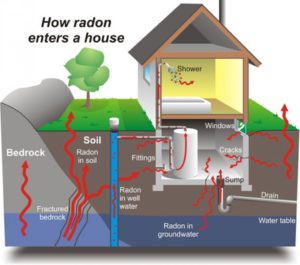![]()
It is highly recommended to test for radon at time of inspection.
Radon and Well Analysis:
Radon is an odorless, colorless radioactive gas which is formed by the breakdown of uranium.
Radon can be found in high concentrations in soils and rocks containing granite, shale, phosphate and uranium, or occasionally industrial waste, in almost any area of the country. Research has shown that once trapped inside a closed structure, Radon can accumulate to the point where a potential health hazard may exist. Actually it is the breakdown of Radon into what is referred to as Radon decay products (or Radon daughters) that represents the greatest concern.
How do Radon Decay Products affect the health of my family?
Radon naturally breaks down to form decay products (Radon daughters) which cling to particles in the air. As you breathe, these particles enter your lungs, emitting bursts of radiation which can damage lung tissue.
Exposure to elevated levels of Radon for extended periods of time can increase the risk of developing lung cancer. Presumed to be the second greatest cause of lung cancer, Radon is estimated to contribute to up to 20,000 deaths per year, according to the U.S. Environmental Protection Agency (EPA).
How does Radon enter my home?
Radon can move into your basement through cracks and pores in concrete walls and floors, dirt floors, floor drains and joints. Radon can also seep into the water of private wells, entering the home whenever water is used.

How do I know if I have elevated levels of Radon in my home?
Since Radon and its decay products are colorless and odorless there is only one way to be sure, and that is to test. Because there are many factors in whether you have elevated levels of Radon in your home, you cannot assume that your home is all right if your neighbors home tested with low levels of Radon
What types of tests are available?
Charcoal Absorption Detector
- These devices contain a quantity of activated charcoal that absorbs Radon during a 48 hour sampling period. The major disadvantages are lack of location placement security and the short monitoring span. Because these devices are not integrating devices, the result may not reflect the true average for the sample period and further testing may be required. The EPA now requires on site testing firms to place two of these devices in the same area either sequentially or concurrently. Results from these devices can vary widely depending upon whether EPA protocols were followed in the handling of the device and the quality control of the manufacturer. (See American Journal of Public Health)
Radon in Water
- Many people do not know that Radon coming from deep wells can be a health problem because of aeration or ingestion. Mitigation or removal of Radon in water can be very costly. A standard water portability test usually does not include Radon, therefore, a Radon in water test should be ordered separately if there is a concern.
Additional Radon information available from the EPA.
